Distributing Content to Another Ektron Folder
Ektron supports the distribution of a community documenteither HTML content or an asset created via the Community Documents server control. to any CMS folder. For example, your Marketing Department uses the Community Documents server control to create and edit content. After completing a press release, they use the Distribute menu option to copy it from the private collaboration folder to a public content folder. When there, the document can pass through an approval chain or be published immediately.
The Distribute option can insert new content or overwrite existing content in any folder.
Enabling the Distribute Option
Only a member of the Ektron Administrators group can enable the Distribute option. Do this for every community group that will use it. You can do so from the Workarea or after logging in to the website.
From the Workarea
- From the Workarea, go to Settings > Community Management > Community Groups.
- Click the group for which you want to enable the Distribute option.
- Click Edit.
- Check the Enable Distribute check box.
- Click Save.
From the Website
- Log in to a site that uses the Community Management features as a CMS administrator or a Group Administrator.
- Navigate to a Web page that hosts a Group Profile page.
- Click Edit Group.
- Check the Enable Distribute check box.
- Click Save.
Distributing a Community Document
WARNING! After a community document is distributed the first time, the original document is forever linked to the destination document. You cannot break the link.
- You log in as one of the following
- Administrator of the group whose documents are being distributed
- Ektron user assigned Community Group Administrator role for that group
- CMS administrator
- The content’s status is Approved.
- You have permission to add, delete, and restore content to the destination folder. (If you do not, the folder doesn’t appear on the folder selection screen.) See Also: Managing Folder and Content Permissions
Distributing a New Community Document
When you distribute a community documenteither HTML content or an asset created via the Community Documents server control. that does not exist in Ektron for the first time, you identify a destination folder and, if required, metadata and taxonomya content-level categorization system that uses one-to-many relationships (such as Ronald Reagan is to Actor, Governor, and President) to create a scalable organization of content. A taxonomy lets your site visitors navigate content independent of the folder structure. categories. This information is collected through a series of screens that guide you through the process.
- Log in to the website that contains content you want to distribute.
- Navigate to the Web page that contains content you want to distribute.
- Click the triangle to the right of the content or asset you want to distribute.
- Click Distribute from the drop-down menu. The following screen appears.—Image—

- Click in the top box, which begins I want to distribute a copy of this item. The following screen appears.—Image—
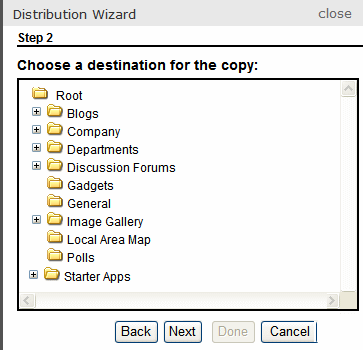
- Select the folder to which you want to distribute the content and click Next. The following screen appears if metadata or a taxonomy category is required for the folder.—Image—
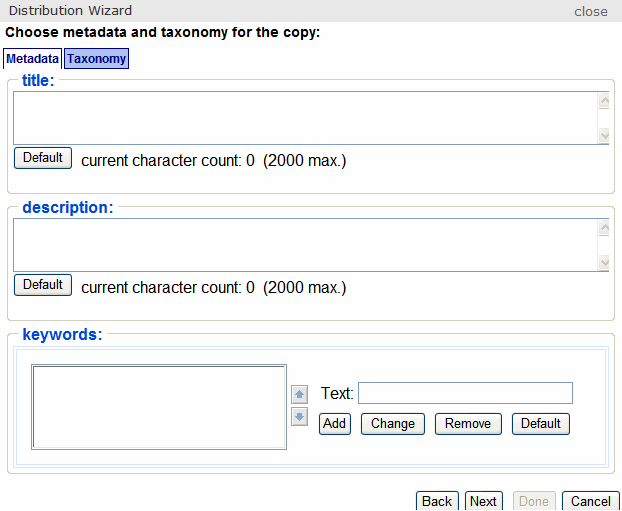
- Enter any required metadata or taxonomya content-level categorization system that uses one-to-many relationships (such as Ronald Reagan is to Actor, Governor, and President) to create a scalable organization of content. A taxonomy lets your site visitors navigate content independent of the folder structure.. A confirmation message appears.
- Click Done. Ektron copies the selected document to the designated folder.—Image—
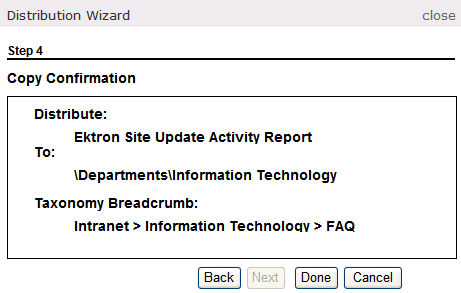
Distributing and Overwriting a Community Document
NOTE: This process only occurs the first time you overwrite a document. For a description of subsequent updates, see Distributing Content After the First Distribution.
During this procedure, you identify a destination folder and content to be replaced. Because the content’s type that you are distributing must match the content being replaced, you only see content whose types match.
Upon replacing, any metadata and taxonomy categories applied to the existing content are applied to the new. Also, the content title and ID number from the existing content are maintained—they are not replaced by the title and ID number of the new content. Finally, the existing content’s summary is maintained and can be edited if needed.
- Log in to the website that contains the content you want to distribute.
- Navigate to the page that contains that content.
- Click the triangle to the right of the document you want to distribute. Distribute appears on the drop-down menu.
- Click Distribute. The following screen appears.
NOTE: The following screen only appears the first time you overwrite a file. To overwrite the file subsequently, see Distributing Content After the First Distribution.
—Image—
- Click the lower box, which begins I want to replace an existing item. The following screen appears.—Image—

- Navigate to and select the content you want to replace. Only content whose type matches the document you selected appears.
- Click Next. A confirmation message appears.
- Click Done.—Image—
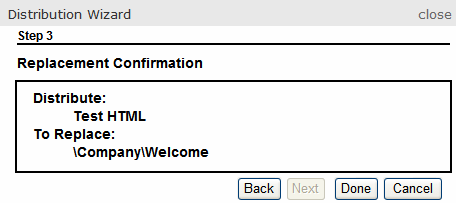
- Ektron overwrites the selected document with the one you selected.
Distributing Content After the First Distribution
If you later try to Distribute the same document (whether you added a new document or overwrote an existing one), a screen like the following appears.
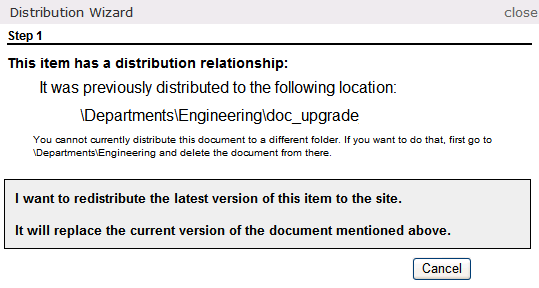
If you really must distribute the document to another folder, delete the document in the destination folder. This action breaks the link between documents. When the link is broken, you can distribute the document to another folder.
To copy the latest version of the document to the distribution folder, click the gray box whose text begins I want to redistribute... However, you cannot distribute the document to another folder. (If you want to do so, first delete the document from the destination folder. Then, you can use either procedure to distribute the document to any folder.)
When distributing content after the first time, its metadata and taxonomya content-level categorization system that uses one-to-many relationships (such as Ronald Reagan is to Actor, Governor, and President) to create a scalable organization of content. A taxonomy lets your site visitors navigate content independent of the folder structure. categories appear on the Metadata/Category screen by default. You can change them if desired.
As with the replace option, the existing content’s title and ID number are maintained -- they are not replaced by the new content’s title and ID number. And, the existing content’s summary is maintained and can be edited if needed.